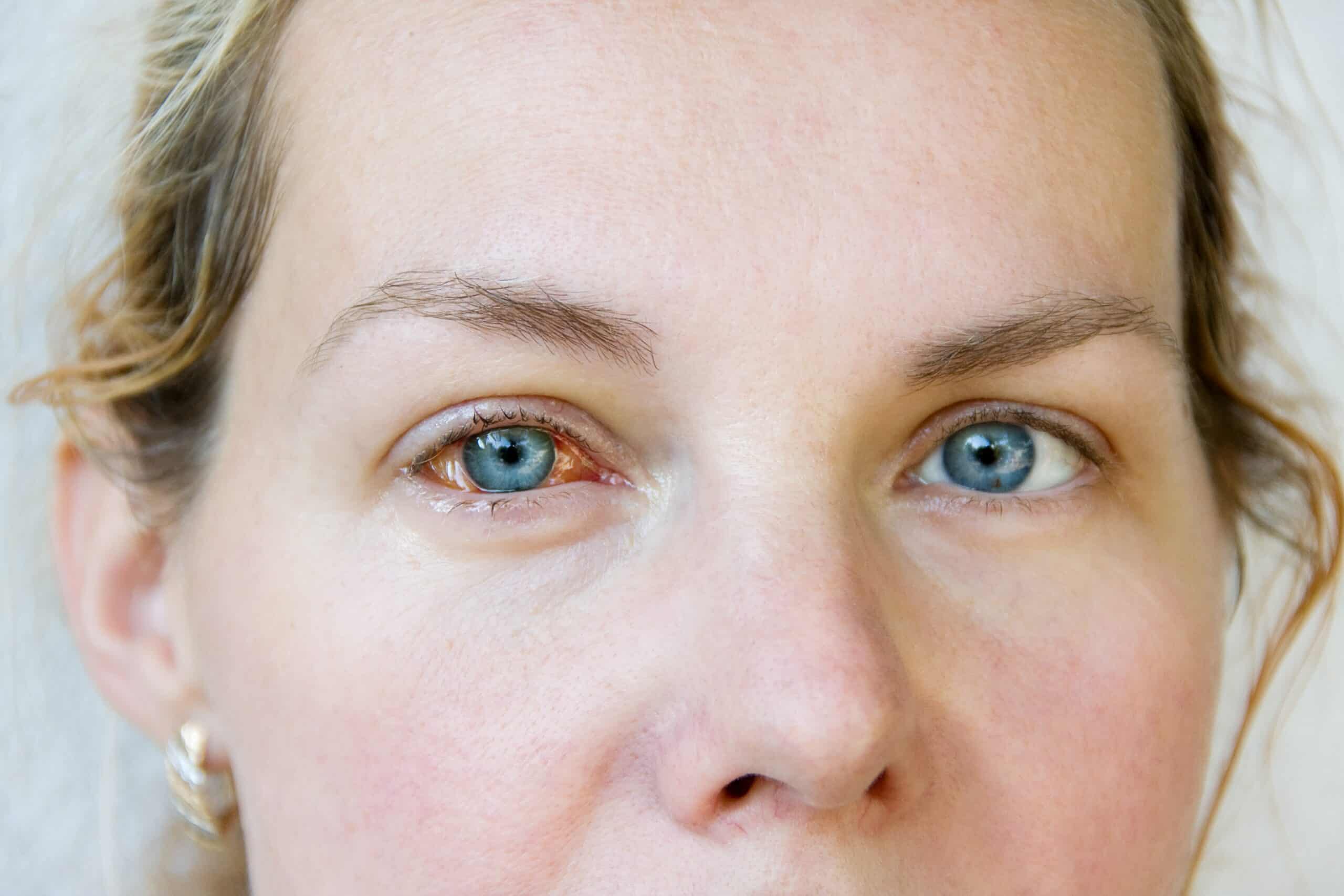 Medically reviewed by Dr. Matthew Fainman Virtual Care Medical Director at NextCare. Dr Fainman is an experienced Internal Medicine specialist, who earned his Bachelor’s, MBA, and Medical Doctorate from the University of Manitoba. He completed his residency at Cleveland Clinic and, with over 20 years in healthcare, is a leader in Telehealth innovation and patient care.
Medically reviewed by Dr. Matthew Fainman Virtual Care Medical Director at NextCare. Dr Fainman is an experienced Internal Medicine specialist, who earned his Bachelor’s, MBA, and Medical Doctorate from the University of Manitoba. He completed his residency at Cleveland Clinic and, with over 20 years in healthcare, is a leader in Telehealth innovation and patient care. Dealing with a painful or irritated eye can be really worrisome. If you’re experiencing these symptoms, you may be wondering how to treat keratitis. Keratitis is an eye disease that involves inflammation of the cornea – the transparent front part of your eye. Learning how to treat keratitis quickly can help prevent complications and preserve your vision.
We’ll discuss different types of keratitis, explore common symptoms, and uncover effective treatments. You’ll also learn about preventive measures to minimize your chances of encountering this eye condition.
What is Keratitis?
Keratitis is a condition that affects the cornea. The cornea acts as a shield, safeguarding the front of your eye. It also focuses light to provide clear vision. Keratitis can occur due to an infection (infectious keratitis) or from an injury or other non-infectious causes. Sometimes, people refer to keratitis as a “corneal ulcer,” especially when it involves an open sore.
Types of Keratitis
Keratitis manifests in two main categories based on its source: infectious and non-infectious. Infectious keratitis is caused by bacteria, viruses, fungi, or parasites invading the eye. Non-infectious keratitis often stems from eye injuries, excessive contact lens wear, or dry eyes, among other causes.
Infectious Keratitis:
- ⊕ Bacterial Keratitis: Often linked to improper contact lens hygiene or prolonged wear. It’s the most prevalent type of infectious keratitis. Bacterial keratitis can cause corneal ulcers if left unchecked.
- ⊕ Viral Keratitis: Typically caused by herpes viruses like herpes simplex virus and herpes zoster (the cause of shingles). It can reappear and affect both the cornea’s surface and deeper layers.
- ⊕ Fungal Keratitis: While rarer than other forms, fungal infections can be severe. Plant material scratching the eye often introduces fungal keratitis.
- ⊕ Parasitic Keratitis: Parasites, specifically Acanthamoeba, can lead to acanthamoeba keratitis. This is mainly found in contact lens users. Swimming with contacts significantly increases this risk.
Non-infectious Keratitis:
- ⊕ Corneal Abrasions: Occur when something scratches or damages the cornea.
- ⊕ Exposure Keratitis: Results from insufficient eyelid closure, as seen in conditions like Bell’s palsy. This leaves the ocular surface exposed and dry, leading to irritation and inflammation.
- ⊕ Ultraviolet Keratitis: Commonly known as “snow blindness,” it develops after exposure to intense UV radiation. This is often from sunlight reflected off snow or water.
- ⊕ Contact Lens-Induced Keratitis: Not only can contact lenses carry infections, but prolonged use can irritate the cornea.
Keratitis Symptoms and Diagnosis
Keratitis can seriously impact your vision. Knowing the symptoms is crucial for getting prompt treatment and preventing potential complications.
Common Symptoms of Keratitis:
Keratitis can bring a bunch of annoying symptoms, including:
- ⊕ Pain and Discomfort: Your eye might feel achy, scratchy, or burning.
- ⊕ Redness and Bloodshot Eyes: The white of the eye may turn pink or red.
- ⊕ Blurred Vision: Your eyesight may get foggy, cloudy, or hazy.
- ⊕ Tearing: Your eye may water more than usual.
- ⊕ Discharge: You might notice pus-like or sticky fluid coming from your eye.
- ⊕ Sensitivity to Light (Photophobia): Bright lights might cause discomfort or pain.
- ⊕ Swollen Eyelids: Your eyelids might become puffy and tender.
- ⊕ Difficulty Opening the Eye: Your eyelids might feel heavy or painful, making it hard to open your eye.
NextCare Urgent Care offers prompt medical attention for eye infections, including keratitis, providing treatment options to prevent long-term complications. If you notice any of these symptoms, it’s essential to seek professional care immediately.
How a Doctor Diagnoses Keratitis
An eye doctor, like an ophthalmologist, diagnoses keratitis by conducting a detailed eye exam. They consider your medical history and may use specialized tools and techniques to assess your cornea:
- ⊕ Slit-Lamp Examination: A specialized microscope magnifies the cornea, enabling the doctor to check for irregularities.
- ⊕ Fluorescein Stain: A fluorescein stain illuminates corneal damage under a blue light.
- ⊕ Corneal Scrapings: Sometimes, a sample from the cornea is analyzed to identify the cause of the infection.
How to Treat Keratitis: The Right Treatment for You
Knowing how to treat keratitis hinges on pinpointing what triggered it. Treatment plans vary based on the source of the problem, with infectious keratitis requiring medication to eliminate the invaders.
Infectious Keratitis Treatment
Infectious keratitis treatments aim to eliminate the underlying infection and promote healing. Here’s how different types are usually addressed:
- ⊕ Bacterial Keratitis: Frequent contact lens-related bacterial infections require potent antibiotic eyedrops. Some instances might even call for additional oral antibiotics. Depending on the seriousness of the infection, you might use eye drops as often as every 30 minutes. However, your doctor will advise the exact dosage and frequency.
- ⊕ Viral Keratitis: Depending on the virus causing the problem, treatment may involve antiviral eyedrops and oral medications. Herpes simplex virus, for example, can be effectively treated this way. For viruses not responding well to antiviral medicine, artificial tear drops help provide comfort.
- ⊕ Fungal Keratitis: Antifungal eye drops and pills work together to tackle fungal infections. The treatment process might take longer to fully resolve, requiring meticulous attention and patience.
- ⊕ Parasitic Keratitis: Dealing with the parasite, Acanthamoeba, often requires consistent use of anti-parasitic eye drops. The catch is that some stubborn infections might resist this treatment, extending the duration for several months. Cases that worsen despite treatments could necessitate a cornea transplant as a last resort.
Non-Infectious Keratitis Treatment:
Treatment for non-infectious keratitis depends on the severity and cause. Here are some common approaches:
- ⊕ Lubricating Eye Drops: Used generously to keep the cornea moist, especially in cases like exposure keratitis.
- ⊕ Eye Drops for Swelling: Some eye drops reduce inflammation and swelling associated with irritation.
- ⊕ Bandage Contact Lenses: Can act as a protective covering over the cornea, speeding up healing.
- ⊕ Eye Patching: For certain injuries or after procedures, this shields the eye, aiding rest and recuperation.
Treatment for Severe Keratitis:
If medications alone don’t solve the issue or if persistent inflammation results in permanent corneal scarring impacting your vision, a doctor might propose a corneal transplant. It’s crucial to discuss this treatment thoroughly with your healthcare professional.
Preventive Measures for Keratitis
By adopting a few preventive measures, you can reduce your risk factor for developing this condition:
For Contact Lens Users:
When wearing contact lenses, proper handling and hygiene become especially crucial for preventing keratitis:
- ⊕ Thorough Cleaning: Disinfect your lenses religiously with the prescribed solution.
- ⊕ Fresh Solution Daily: Never top off old solution in your lens case; always start with fresh disinfectant.
- ⊕ Replace Regularly: Adhere to the replacement schedule for both lenses and lens cases.
- ⊕ No Swimming or Showering: Resist wearing contacts in water, particularly hot tubs, to avoid exposure to bacteria, fungi, and amoeba.
- ⊕ Clean Hands: Before touching your contacts or your eyes, wash and dry your hands meticulously to prevent bacteria transfer.
General Eye Care:
Here are additional ways to prioritize eye health and minimize your chances of developing keratitis:
- ⊕ Protection from UV Rays: Invest in quality sunglasses offering sufficient UV protection.
- ⊕ Eye Safety Gear: Don appropriate safety glasses or goggles during work and sports activities to shield your eyes from debris, splashes, and other hazards.
- ⊕ Addressing Dry Eyes: If you have persistent dryness, use over-the-counter lubricating eye drops and talk to an eye doctor about other treatments.
- ⊕ Regular Eye Exams: Visiting your eye doctor for routine checkups is paramount. Early detection and intervention play a significant role in preventing irreversible vision issues.
Understanding the Gravity of Untreated Keratitis: The Risks You Take
If not caught early or not taken seriously, neglecting how to treat keratitis properly can snowball into major eye troubles. Here’s why dealing with it swiftly is essential:
- ⊕ Vision Loss: Chronic inflammation can lead to scarring and cloudy corneas. This impairs clear vision and, if severe enough, could even lead to complete vision loss. Early treatment significantly reduces this risk.
- ⊕ Chronic Pain: Untreated inflammation often translates into lingering pain. This isn’t just a minor annoyance; it can drastically disrupt daily activities and sleep patterns.
- ⊕ Other Eye Issues: Persistent corneal problems have the potential to pave the way for additional eye complications. The infection might even spread deeper, reaching sensitive structures. This can lead to severe discomfort, further impacting your vision, and demanding more complex treatment down the line.
Conclusion
Dealing with a sore, irritated, or blurry eye is more than a passing inconvenience—it could signify a need to understand how to treat keratitis. Knowing how to treat keratitis requires early attention to those signs. Get immediate medical attention for persistent pain, redness, blurred vision, or unusual discharge to prevent more serious eye complications and vision loss.
Disclaimer: Treatment options are tailored to the patient’s current condition and the examples are to be used as possible treatment options. The actual treatment will be determined after an assessment performed by a medical professional. Additionally, procedures are recommended only after a comprehensive evaluation and a thoughtful determination of the most appropriate treatment options.
